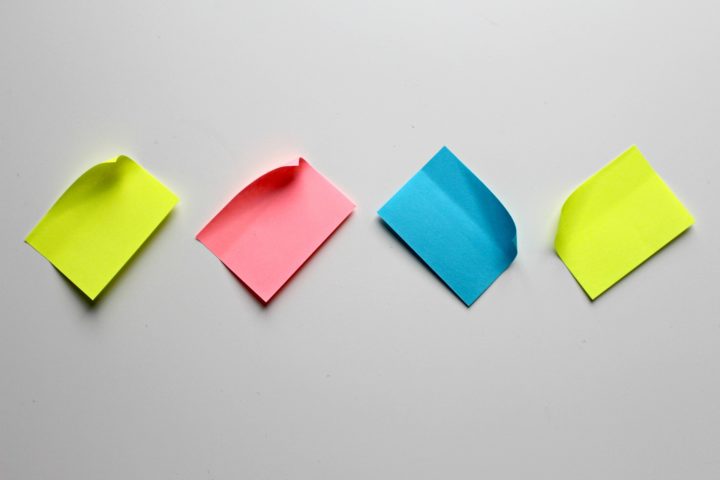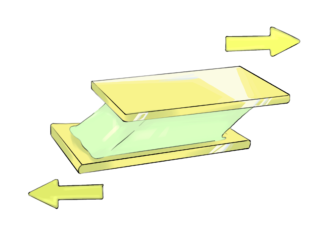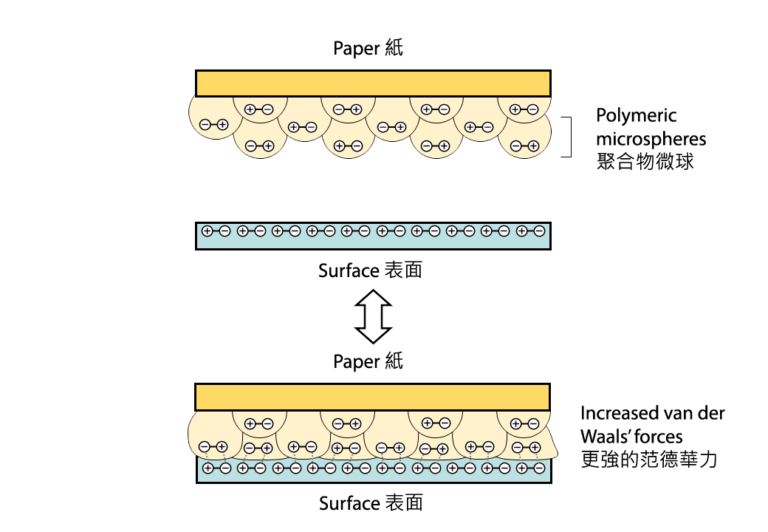How Do Sticky Notes Work?
By April Lam 林芷因

Post-it notes are undoubtedly easy and convenient to use. Not only can they be placed anywhere without fasteners (i.e. tacks, paper clips, or staples), they do not easily fall off, nor leave any glue stains. Accepted as part of our many modern day conveniences, one rarely thinks about why this is possible in the first place.
History of Sticky Notes
Spencer Silver was a research chemist developing adhesives strong enough for aircraft construction [1]. In his attempts to invent such an adhesive, Silver instead discovered a weak adhesive that could be peeled on and off without losing its “stickiness [2].” While many may have thought this to be a useless invention, Silver’s colleague Art Fry gave him the idea of using the adhesive to create removable paper bookmarks for his choir hymn book. This moment in history led to the invention of Post-it notes.
How to Describe the Strengths of Adhesives?
Adhesives have two kinds of strengths that make up the adhesive bond: shear strength and peel strength. As illustrated in Figure 1, shear strength is measured by the forces pulling in a direction parallel to the two surfaces joined by the adhesive. Peel strength, on the other hand, is measured by the forces perpendicular to the two surfaces.
 |
 |
|
Shear Strength |
Peel Strength |
Figure 1 Shear Strength and Peel strength.
For a Post-it note to be useful, it should have moderate shear strength to allow firm yet temporary attachment to a surface, while also having low peel strength to allow removal without tearing [3].
Why Are Polymer Adhesives Sticky?
Before looking into the unique properties of sticky notes, let’s try to understand why they can stick to surfaces in the first place. Polymers are used as adhesives in the making of Post-it notes. These are large, long-chain molecules formed by repeating monomer units through a process called polymerization. When polymers come into contact with a surface, van der Waal’s forces will form between the polymers and the molecular surface of the object, causing them to stick together. Almost all polymer adhesives work using these interactions [4].
When producing polymer adhesives for a specific purpose, scientists typically mix different ratios of monomers to modify the properties of the resulting polymer. This process results in a copolymer, defined as polymers formed from more than one type of monomer. To produce the adhesive mixture to be sprayed on sticky notes, Silver found the ideal ratio to be 95 to 99 percent of acrylate monomer, and 1 to 5 percent of mixtures containing ionic monomers and maleic anhydride [5]. In other words, small amounts of acrylate monomers are substituted with ionic monomers and maleic anhydride to form long, cross-linked chains. Such modifications can improve the elastic properties of the copolymer, and allow the adhesive to be produced as an aerosol spray [5].
How Do Sticky Notes Work?
But why can you stick and unstick a Post-it effortlessly? The copolymer is actually produced in the form of microspheres with diameters as small as 50 to 75 µm [6]. A single layer of sparsely spaced microspheres are sprayed on the paper of the Post-it note, which looks like the bumpy surface of a basketball under a microscope, with little glue bubbles protruding from the flat surface [7]. As illustrated in Figure 2, when force is applied to stick a Post-it note onto a surface, the elastic microspheres are flattened and cling to the surface. The flattening of microspheres temporarily provides an increased surface area for adhesion, and hence greater van der Waal’s forces for attachment [8]. But these interactions are still not very strong, so the Post-it can be peeled off just as easily. Conveniently, re-sticking of the Post-it is allowed without adding extra adhesive because no significant levels of adhesive will be lost on the surface after removal [7]. The deformed microspheres are known to regain their spherical shape for another round of sticking [5]. However, Post-it notes do have a limited life span. With every attachment and removal, dust and dirt accumulate onto the sticky microspheres. This diminishes the contact area with the surface, and hence reduces van der Waal’s interactions. Therefore the Post-it note will gradually lose its stickiness.

Figure 2 Representation of the forces responsible for polymeric adhesion of Post-it notes.
Believe it or not, Post-it notes have been sticking around for 43 years since its invention! From bookmarks to annotating documents and brainstorming in meetings, Post-it notes have served as an indispensable addition to our daily life, boosting productivity. The next time you grab a Post-it note to mark down a thought, be sure to remember this eureka moment of Silver and Fry’s discovery.
| Fun Fact: The iconic canary yellow of Post-it is actually chosen by chance as the lab next to Silver’s only had pale yellow scrap paper to use during development [9]. |
References:
[1] Sandomir, R. (2021, May 13). Spencer Silver, an Inventor of Post-it Notes, Is Dead at 80. The New York Times. https://www.nytimes.com/2021/05/13/business/spencer-silver-dead.html
[2] BBC. (n.d.). Creativity and innovation. BBC Bitesize. https://www.bbc.co.uk/bitesize/guides/z3csycw/revision/2
[3] Plummer, C. (1993, December). The Story of Post-ItTM Notes. ChemMatters. https://www.borlik.org/wp-content/uploads/2015/08/Post-It-Notes.pdf
[4] Kovalev, A., & Sturm, H. (2013). Polymer Adhesion. In: Q. J. Wang, & Y. W. Chung (Eds), Encyclopedia of Tribology (pp. 2551-2556). Springer. https://doi.org/10.1007/978-0-387-92897-5_816
[5] Silver, S. F. (1972). U.S. Patent No. 3,691,140. U.S. Patent and Trademark Office.
[6] Fry, A. L. (1993). U.S. Patent No. 5,194,299. U.S. Patent and Trademark Office.
[7] Merrill, R. F., Jr., & Courtney, H. R. (1974). U.S. Patent No. 3,857,731. U.S. Patent and Trademark Office.
[8] University of Cambridge. (2013, July 25). What makes things sticky? The Naked Scientists. https://www.thenakedscientists.com/articles/questions/what-makes-things-sticky
[9] Huynh, R. (2021, August 3). Colour Story: Canary Yellow. https://blog.glaciermediadigital.ca/index.php/2021/08/03/colour-story-canary-yellow/